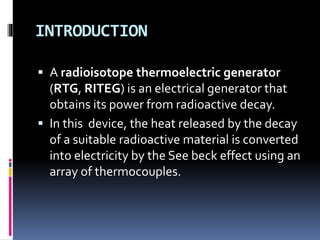Generator for space shuttles-Radioisotope thermoelectric generator
- 2. INTRODUCTION ’é¦ A radioisotope thermoelectric generator (RTG, RITEG) is an electrical generator that obtains its power from radioactive decay. ’é¦ In this device, the heat released by the decay of a suitable radioactive material is converted into electricity by the See beck effect using an array of thermocouples.
- 3. TYPICAL CUT-OUT OF RTG
- 4. CONSTRUCTION & DESIGN ’é¦ The design of an RTG is simple by the standards of nuclear technology the main component is a sturdy container of a radioactive material (the fuel). ’é¦ Thermocouples are placed in the walls of the container, with the outer end of each thermocouple connected to a heat sink. ’é¦ Radioactive decay of the fuel produces heat which flows through the thermocouples to the heat sink, generating electricity in the process.
- 5. Desirable Characteristics of Fuel For RTG ’é¦ High energy output ’é¦ Easy absorption and conversion into thermal radiation ’é¦ Long half life ’é¦ High specific power output ’é¦ Low shielding requirements A PLUTONIUM238Pu PELLET
- 6. FUELS(ISOTOPES) ’é¦ Plutonium-238 ’é¦ curium-244 ’é¦ strontium-90 ’é¦ polonium-210 ’é¦ promethium-147, ’é¦ caesium-137, ’é¦ cerium-144, ruthenium-106, cobalt-60, etc..
- 7. Potential Fuels for RTG 238Pu 90Sr 210Po 241Am Shielding (mm of lead) 2.5 16 100 18 Half life (years) 87.7 28.78 0.38 432.7 Specific Power (Wg-1) 0.448 0.128 17.81 0.089
- 9. LIFESPAN ’é¦ Most RTGs use 238Pu, which decays with a half-life of 87.7 years. RTGs using this material will therefore diminish in power output by 0.787% of their capacity per year. 23 years after production, such an RTG will have decreased in power by 16.6%, i.e. providing 83.4% of its initial output.Thus, with a starting capacity of 470W, after 23 years it would have a capacity of 392W.
- 10. EFFICIENCY ’é¦ Higher efficiency means less radioactive fuel is needed to produce the same amount of power and therefore a lighter overall weight for the generator. ’é¦ Thermocouples used in RTGs are very reliable and long lasting, but are very inefficient. ’é¦ So efficiency above 10% have never been achieved and most RTGs have efficiency between 3 to 7 %.
- 11. SAFETY ’é¦ RTGs may pose a risk of radioactive contamination: if the container holding the fuel leaks, the radioactive material may contaminate the environment. ’é¦ Iridium cladding ’é¦ Graphite aero-impact shell ’é¦ Composite covering ’é¦ Alloying
- 12. Applications ’é¦ Used as power sources in satellites, space probes and unmanned remote facilities. ’é¦ Used as power sources for navigation beacons, radio beacons, light houses and weather stations. ’é¦ Used at places where solar cells are not viable. ’é¦ Most desirable power source for unmanned and unmaintained situations needing a few 100 watts or less of power of durations too long for fuel cells, batteries and generators.
- 13. Challenges ’é¦ Low overall efficiencies (6 - 7%) ’é¦ Degradation of thermoelectric elements ’é¦ Design of effective thermal path ’é¦ Breakdown of insulators
- 14. THANKYOU!!!














